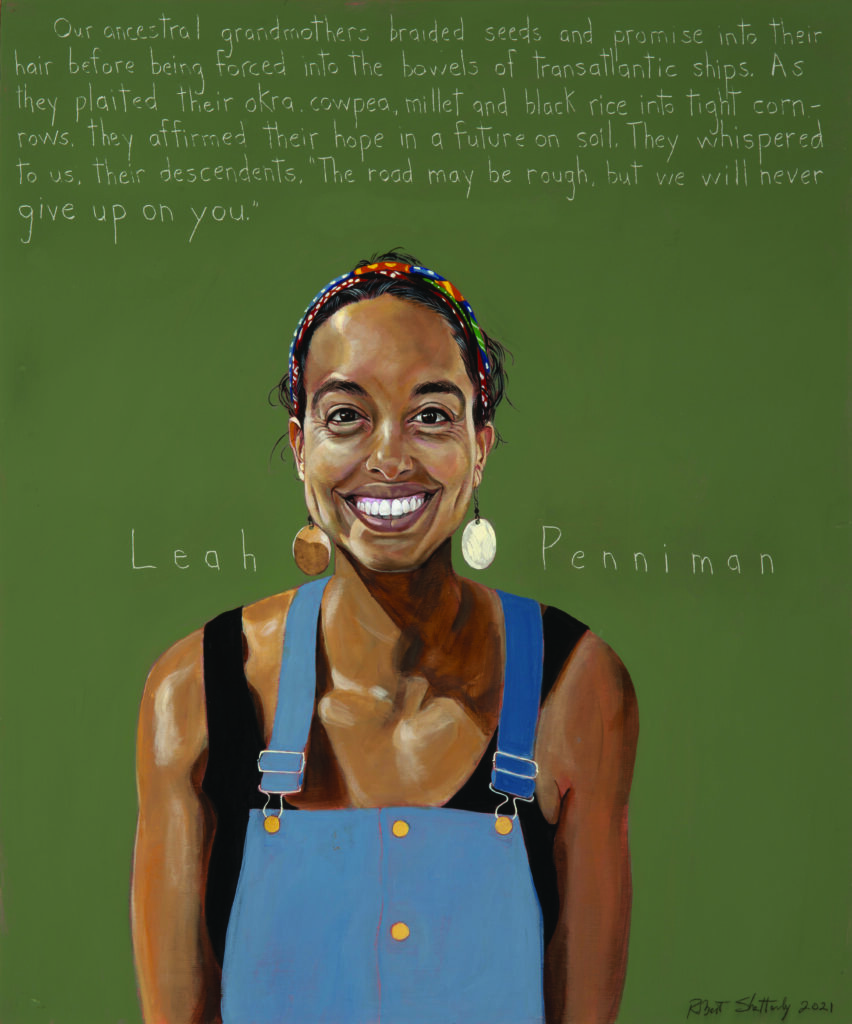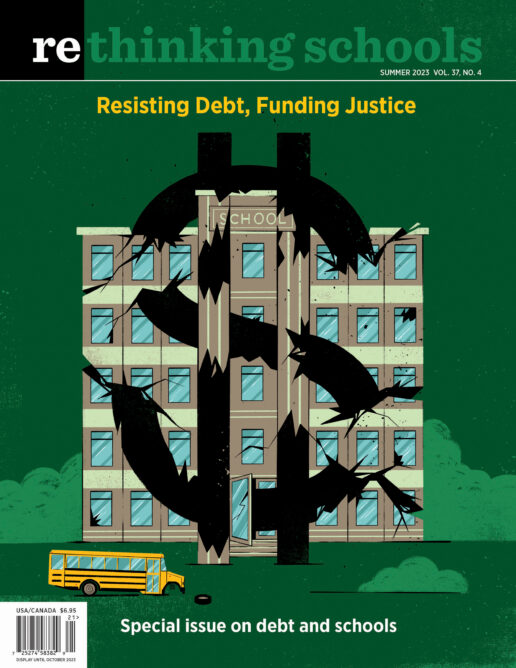Black Land Matters
Illustrator: Robert Shetterly

Dijour Carter refused to get out of the van parked in the gravel driveway at Soul Fire Farm in Grafton, New York. The other teens in his program emerged, skeptical, but Dijour lingered in the van with his hood up, headphones on, eyes averted. There was no way he was going to get mud on his new Jordans and no way he would soil his hands with the dirty work of farming. I didn’t blame him. Almost without exception, when I ask Black visitors to the farm what they first think of when they see the soil, they respond with “slavery” or “plantation.” Our families fled the red clays of Georgia for good reason — the memories of chattel slavery, sharecropping, convict leasing, and lynching were bound up with our relationship to the Earth. For many of our ancestors, freedom from terror and separation from the soil were synonymous.
While the adult mentors in Dijour’s summer program were fired up about this field trip to a Black-led farm focused on food justice, Dijour was not on board. It was only when he saw the group departing on a tour that his fear of being left alone in a forest full of bears overcame his fear of dirt. He joined us, removing his Jordans to protect them from the damp earth and allowing, at last, the soil to make direct contact with the soles of his bare feet.
Dijour, typically stoic and reserved, broke into tears during the closing circle at the end of that day. He explained that when he was very young, his grandmother had shown him how to garden and how to gently hold a handful of soil teeming with insects. She had died years ago, and he had forgotten these lessons. When he removed his shoes on the tour and let the mud reach his feet, the memory of her and of the land traveled from the earth, through his soles, and to his heart. He said that it felt like he was “finally home.”
Our Sacred Ancestral Relationship with Soil
Our 12,000-year history of noble, autonomous, and dignified relationship to land far surpasses the 246 years of enslavement and 75 years of sharecropping in the United States. As Black farmer Chris Bolden-Newsome explains, “The Land was the scene of the crime.” I would add, “She was never the criminal.”
Our ancestral grandmothers in the Dahomey region of West Africa braided seeds of okra, molokhia, and levant cotton into their hair before being forced to board transatlantic slave ships. They hid sesame, black-eyed peas, rice, and melon seed in their locks. They stashed away amara kale, gourd, sorrel, basil, tamarind, and kola in their tresses. The seed was their most precious legacy, and they believed against odds in a future of tilling and reaping the earth. They believed that we, Black descendants, would exist and that we would receive and honor the gift of the seed.
With the seed, our grandmothers also braided their ecosystemic and cultural knowledge. African people, expert agriculturalists, created soil testing systems that used taste to determine pH and touch to determine texture. Cleopatra developed the first vermicomposting systems, warning citizens that they would face harsh punishment for harming any worm. Ghanaian women created “African Dark Earth,” a compost mixture of bone char, kitchen scraps, and ash that built up over generations, capturing carbon, and fertilizing crops. African farmers developed dozens of complex agroforestry systems, integrating trees with herbs, annuals, and livestock. They built terraces to prevent erosion and invented the most versatile and widely used farming tool — the hoe. Our people invented the world’s initial irrigation systems 5,000 years ago and watered the Sahel with foggaras [underground water conduits] that are still in use today. They domesticated the first livestock and established rotational grazing that created fertile ground for grain crops.
Our ancestors created sophisticated communal labor systems, cooperative credit organizations, and land-honoring ceremony. On Turtle Island, Black agriculturalists like Booker T. Whatley, George Washington Carver, Fannie Lou Hamer, and Harriet Tubman brought us the CSA (community supported agriculture), organic/regenerative farming, cooperative farms, land trusts, and herbalism. Even as the colonizers pillaged the soil of 50 percent of its carbon in their first generation of settling, we used ancestral techniques like mounding, deep mulching, plant-based toxin extraction, and cover cropping to welcome life back into the soil. Our ancestral grandmothers braided all this wisdom and more into their hair and brought it across the Middle Passage. It is our heritage.
A New Generation
A new generation of Black farmers is using heritage farming practices to undo some of the damage first brought on by the intense tillage of early European settlers. Their practices drove around half of the organic matter from the soil into the sky as carbon dioxide. Agriculture continues to have a profound impact on the climate; along with forestry, deforestation, and other land use, it contributes roughly 24 percent of global greenhouse gas emissions.
Now Black farmers are using heritage practices to reduce emissions and to capture excess carbon from the air and trap it in the soil. Our ancestral strategies are bolstered by Western science and listed among the most substantive solutions to global warming, per Project Drawdown’s analysis.
One practice, silvopasture, is an Indigenous system that integrates nut and fruit trees, forage, and grasses to feed grazing livestock. Another, regenerative agriculture, involves minimal soil disturbance, organic production, compost application, the use of cover crops, and crop rotation. Both systems harness plants to capture greenhouse gases. Plants are nature’s alchemists, transforming atmospheric carbon dioxide into sugar and trapping it on the land where it belongs.
The soil stewards of generations past recognized that healthy soil is not only imperative for our food and climate security — it is also foundational for our cultural and emotional well-being. My teachers, the Queen Mothers of Odumase Krobo, Ghana, admonished, “How can it be that you Americans put a seed in the ground, and you do not pray, sing, dance, or pour libations and you expect the Earth to feed you? The Earth is a relative, not a commodity. That is why you are all sick!”
In every generation there were Black people who remembered the gift of the seed and the legacy of belonging to the land. We pay homage to one such rememberer, Fannie Lou Hamer, who said, “When you have 400 quarts of greens and gumbo soup canned for the winter, no one can push you around or tell you what to do.” In 1969, Hamer founded the Freedom Farm Cooperative on 40 acres of prime delta land. Her goal was to empower poor Black farmers and sharecroppers, who had suffered at the mercy of white landowners. “The time has come now when we are going to have to get what we need ourselves,” she said. “We may get a little help, here and there, but in the main we’re going to have to do it ourselves.” The co-op consisted of 1,500 families who planted cash crops, like soybeans and cotton, as well as mixed vegetables. They purchased another 640 acres and started a “pig bank” that distributed livestock to Black farmers. The farm grew into a multifaceted self-help organization, providing scholarships, home-building assistance, a commercial kitchen, a garment factory, a tool bank, agricultural training, and burial fees to its members. Thank you, Mama Hamer, for keeping the seed alive.
The seed is passed to us, Black children of Black gold. If we do not figure out how to continue the legacy of our agricultural traditions, this art of living on land in a sacred manner will go extinct for our people. Then, the KKK, the White Citizens’ Councils, and Monsanto will be rubbing their hands together in glee, saying, “We convinced them to hate the earth, and now it’s all ours.” We will not let the colonizers rob us of our right to belong to the Earth and to claim agency in the food system. We are Black Gold — our melanin-rich skin the mirror of the sacred soil in all her hues. We belong here, bare feet planted firmly on the land, hands calloused with the work of sustaining and nourishing our community.

